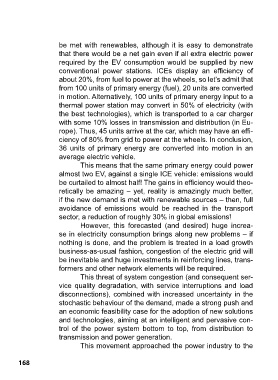Page 168 - UNAM-GCUB2022
P. 168
be met with renewables, although it is easy to demonstrate
that there would be a net gain even if all extra electric power
required by the EV consumption would be supplied by new
conventional power stations. ICEs display an efficiency of
about 20%, from fuel to power at the wheels, so let’s admit that
from 100 units of primary energy (fuel), 20 units are converted
in motion. Alternatively, 100 units of primary energy input to a
thermal power station may convert in 50% of electricity (with
the best technologies), which is transported to a car charger
with some 10% losses in transmission and distribution (in Eu-
rope). Thus, 45 units arrive at the car, which may have an effi-
ciency of 80% from grid to power at the wheels. In conclusion,
36 units of primary energy are converted into motion in an
average electric vehicle.
This means that the same primary energy could power
almost two EV, against a single ICE vehicle: emissions would
be curtailed to almost half! The gains in efficiency would theo-
retically be amazing – yet, reality is amazingly much better,
if the new demand is met with renewable sources – then, full
avoidance of emissions would be reached in the transport
sector, a reduction of roughly 30% in global emissions!
However, this forecasted (and desired) huge increa-
se in electricity consumption brings along new problems – if
nothing is done, and the problem is treated in a load growth
business-as-usual fashion, congestion of the electric grid will
be inevitable and huge investments in reinforcing lines, trans-
formers and other network elements will be required.
This threat of system congestion (and consequent ser-
vice quality degradation, with service interruptions and load
disconnections), combined with increased uncertainty in the
stochastic behaviour of the demand, made a strong push and
an economic feasibility case for the adoption of new solutions
and technologies, aiming at an intelligent and pervasive con-
trol of the power system bottom to top, from distribution to
transmission and power generation.
This movement approached the power industry to the
168

